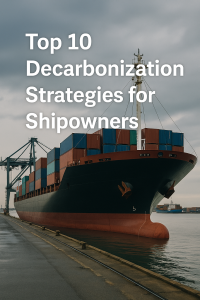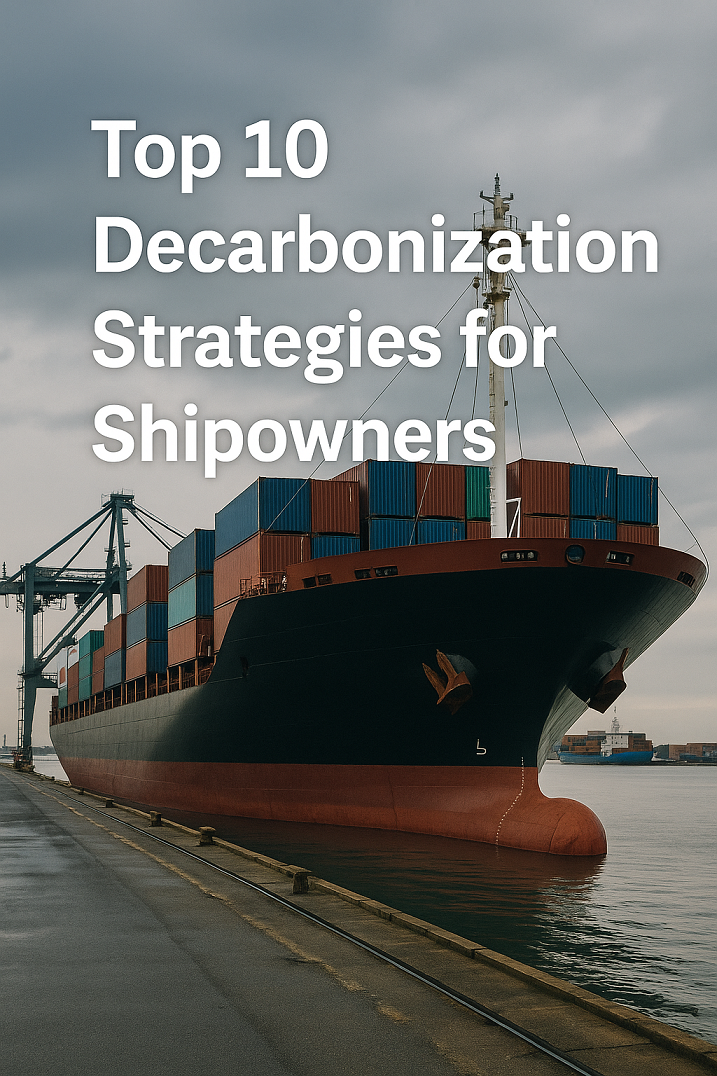Explore the top 10 decarbonization strategies for shipowners. Learn how technologies, fuels, and operational efficiencies are shaping low-emission shipping in response to IMO 2050 goals.
Why Decarbonization Strategies Matter in Modern Maritime Operations
As the global shipping industry faces increasing pressure to align with international climate commitments, decarbonization has become a strategic imperative for shipowners. The International Maritime Organization (IMO) aims to reduce greenhouse gas (GHG) emissions from ships by at least 70% by 2050 compared to 2008 levels—with complete decarbonization as the long-term objective. Shipping currently accounts for nearly 3% of global CO₂ emissions. With regulatory tightening under MARPOL Annex VI, as well as market forces and environmental, social, and governance (ESG) demands, shipowners must act now to future-proof their fleets.
According to DNV’s 2024 Maritime Forecast to 2050, decarbonization pathways vary significantly depending on vessel type, trade route, and ship size. A one-size-fits-all solution is neither practical nor cost-effective. Instead, owners are increasingly adopting a portfolio of strategies—from technical retrofits and operational tweaks to fuel transitions and digital optimization.

Top 10 Decarbonization Strategies for Shipowners
1. Fuel Transition to LNG, Methanol, and Ammonia
Why It Matters: Switching from heavy fuel oil (HFO) to low- or zero-carbon alternatives is a direct way to cut CO₂ and particulate emissions.
-
LNG: Offers a 20–30% reduction in CO₂ emissions, though concerns about methane slip persist.
-
Methanol: Gaining traction due to its easier handling and compatibility with existing fuel systems.
-
Ammonia: A zero-carbon fuel under combustion, though toxic and still in the early stages of engine development.
Real-World Application: Maersk has ordered over 20 methanol-fueled vessels to be delivered by 2027, signaling confidence in methanol’s scalability.
Reference: DNV Alternative Fuels Insight Platform
2. Energy Efficiency Existing Ship Index (EEXI) Compliance
Why It Matters: EEXI, effective from January 2023, mandates technical upgrades for existing ships to meet emissions thresholds.
-
Strategies include engine power limitation (EPL), shaft generators, or retrofitting energy-saving devices like pre-swirl ducts.
Implementation Note: EPL reduces fuel consumption by capping maximum power, thereby cutting CO₂ emissions without major structural changes.
External Link: IMO – EEXI Technical Guidance
3. Carbon Intensity Indicator (CII) Optimization
Why It Matters: CII grades vessels (A–E) annually based on fuel efficiency and emissions per cargo tonne-mile.
Operational Impacts: Poor CII ratings could lead to commercial disadvantages. Shipowners must balance speed, cargo load, and voyage planning.
Tools for Compliance:
-
Voyage optimization software
-
Real-time fuel monitoring
-
Dynamic route planning
Analogy: Think of CII like a vehicle emissions score—public, comparable, and commercially significant.
4. Hull Design and Coating Enhancements
Why It Matters: A smoother, more hydrodynamic hull reduces drag and improves fuel efficiency.
Technical Approaches:
-
Air lubrication systems (e.g., Mitsubishi’s MALS technology)
-
Advanced anti-fouling coatings like silicone-based paints
-
Bulbous bow retrofits
Case Study: MOL’s bulk carriers with air lubrication saw up to 8% energy savings on sea trials.
Reference: Journal of the Royal Institution of Naval Architects
5. Wind-Assisted Propulsion Technologies
Why It Matters: Sails, kites, and rotor sails offer fuel savings by harnessing free wind energy, especially on long ocean crossings.
Types in Use:
-
Flettner rotors (Norsepower)
-
Rigid sails (BAR Technologies’ WindWings)
-
Kites (Airseas)
Real-World Example: In 2023, Cargill’s WindWings-powered bulker saw a 30% reduction in fuel on test voyages.
External Link: Norsepower Rotor Sail Solutions
6. Onboard Energy Management and Digitization
Why It Matters: Smart energy management systems can monitor, benchmark, and reduce emissions in real time.
Technologies:
-
Digital twins for engine and voyage simulation
-
AI-based fuel efficiency tracking
-
Integration with fleet performance centers
Example: Wärtsilä’s Energy Management System has been shown to reduce fuel consumption by up to 10%.
7. Cold Ironing (Shore Power)
Why It Matters: Allowing ships to shut down auxiliary engines while docked reduces GHG emissions and port air pollution.
Port Adoption:
-
California mandates shore power for container ships and cruise vessels.
-
Rotterdam and Hamburg offer shore-side electricity connections for select terminals.
Equipment: Requires high-voltage shore connections (HVSC) and compatible ship infrastructure.
External Link: Port of Rotterdam – Shore Power Strategy
8. Carbon Capture and Storage (CCS) Aboard Ships
Why It Matters: CCS could allow fossil fuel use while still meeting IMO targets.
Current Developments:
-
Mitsubishi and K Line trialed a CO₂ capture system aboard an operational vessel in 2022.
-
Alfa Laval is exploring scalable CCS retrofits for tankers and bulkers.
Challenges: Onboard storage, high energy consumption, and infrastructure for CO₂ offloading.
Reference: Alfa Laval Marine Solutions
9. Fleet Renewal and Modular Ship Design
Why It Matters: Retrofitting has limits. Designing new ships optimized for alternative fuels and future upgrades ensures long-term sustainability.
Features of Modular Vessels:
-
Hybrid engine rooms (LNG + battery)
-
Easily upgradable scrubber systems
-
Fuel-agnostic bunkering infrastructure
Example: DNV’s “Fuel Ready” notations support owners in future-proofing ship investments.
External Link: DNV Fuel Ready Ships
10. Crew Training and ESG-Integrated Management
Why It Matters: Technology is only as effective as the crew who operate it. Sustainability must be embedded in company culture.
Initiatives:
-
Green ship management programs
-
ESG reporting aligned with GHG Protocol Scope 1 & 2
-
IMO’s Model Course 4.05 on “Training for ship energy efficiency management plan (SEEMP)”
Stat Insight: According to the ICS, over 60% of shipowners cite lack of trained personnel as a barrier to decarbonization.
–
Case Study: Wallenius Wilhelmsen – Holistic Decarbonization
Wallenius Wilhelmsen, a leader in RoRo shipping, is pursuing a multi-fuel, modular fleet strategy. They have invested in wind-powered ships (the Orcelle Wind concept), zero-emission terminal operations, and shipboard data analytics to reduce emissions.
The company reports a 15% reduction in GHG intensity from 2018 to 2023, aligned with Science Based Targets initiative (SBTi) certification.
FAQ – Shipowner Decarbonization Strategies
Q1: Is decarbonization mandatory for all shipowners?
Yes. Under IMO MARPOL Annex VI, both existing and new vessels must meet evolving emissions standards.
Q2: Which fuel will dominate in the future—methanol, ammonia, or hydrogen?
There is no single winner yet. Methanol is leading in near-term adoption, while ammonia and hydrogen are under development.
Q3: Can older ships meet EEXI and CII requirements without major retrofits?
Yes, through operational adjustments like EPL or voyage optimization, but long-term compliance may require tech upgrades.
Q4: How costly is retrofitting for decarbonization?
Costs vary. For example, retrofitting an LNG system can exceed $10M, while digital optimization software may cost under $500K.
Q5: Are there financial incentives for decarbonization?
Yes. Initiatives like the EU Emissions Trading System (ETS) and Poseidon Principles promote green financing and penalties for polluters.
Q6: Does decarbonization improve vessel resale value?
In many cases, yes. “Green ships” are more attractive to charterers, financiers, and buyers due to future regulation compliance.
Q7: What’s the role of class societies in decarbonization?
IACS members (e.g., DNV, ABS, LR) provide notations, consultancy, and validation services for energy efficiency and alternative fuels.
Conclusion: Charting the Course to Zero Emissions
For shipowners, the path to decarbonization is complex but essential. As international regulations tighten and climate accountability becomes a business priority, adopting a diversified approach that balances fuel technology, operational excellence, and smart investments is key.
Whether through retrofits, next-gen fuels, or digital solutions, the future belongs to owners who act decisively today. Decarbonization isn’t just about compliance—it’s about competitive advantage, reputational strength, and environmental responsibility.
Now is the time to invest, adapt, and lead.

